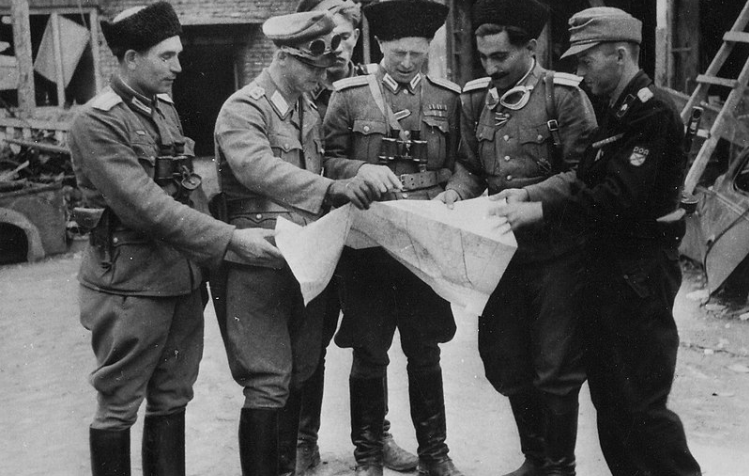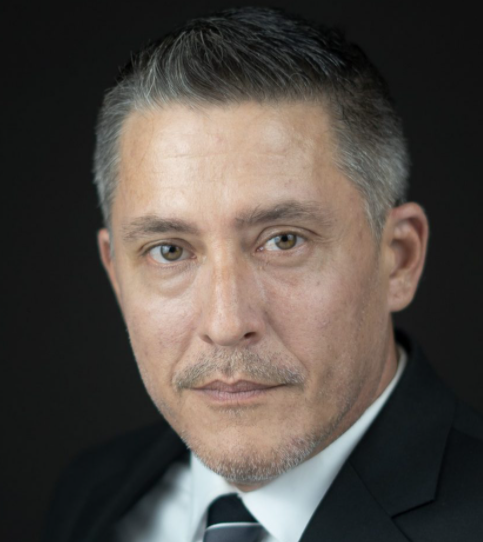Polish participants of the Warsaw Uprising of 1944 in their testimonies and memoirs often incorrectly refer to 'Ukrainians' or the 'Vlasov Army' as the German collaborating forces who were guilty of pillage, rapes, and murders committed against the Warsaw civilians. However, in most cases the reference is to 1,700 soldiers of the Waffen-SS Brigade RONA (Russkaya Osvoboditelnaya Narodnaya Armiya), a Russian collaborating force headed by Waffen Brigadeführer Bronislaw Kaminski. The RONA brigade, at the time of the Warsaw Uprising, was comprised mostly of Russians with Belorussian and Ukrainian minorities. Most were volunteers, ex-POWs, and Red Army deserters. In addition to RONA, German forces included some units formed with volunteers and ex-POWs from various Soviet Union ethnic groups: e.g. Cossacks, Kalmucks, and Azerbaijanis (Bergmann Battalion).
General Andrey Vlasov's (1900-1946) army ROA (Russkaya Osvoboditelnaya Armiya), on the other hand, was formed months after the fall of the Warsaw Uprising.
bronislaw kaminskiBronislaw Kaminski (1899-1944) was born in Witebsk, USSR. He had a Polish father and a German mother. During the 1920s studied chemistry in St. Petersburg and later worked as an engineer in a paint factory. Arrested in July of 1935 by the NKWD (Peoples Commissariat for Internal Affairs) as a Polish and German spy, he was sentenced to ten years of the gulag. Released after five years, he was relocated to the city of Lokot in the Orel-Kursk region.
The Lokot region fell into German hands in October of 1941. Soon afterward, a Russian engineer by the name of Konstantin Woskobojnik (Voskoboinik) was allowed to set up a regional self-governing body later known as the ‘Briansk-Lokot Republic’. Kaminski, initially the second in command, became the head of the ‘republic’ after Woskobojnik’s death in January of 1942 at the hands of the Russian partisans.
Kaminski built the local militia into a 10,000-15,000 man strong brigade. Its soldiers, dressed in Russian-style uniforms, assumed the name of the Russian National Liberation Army, or RONA (POHA in the Russian cyrillic alphabet). Initially, (mid-1942), the brigade was made up of 85% of locals, mostly local Russian* volunteers. The remainder came from Red Army deserters and Russian POWs. The brigade took part in several anti-partisan operations, e.g., in the Orel region in May of 1943 and in Byelorussia in April-May 1944 as well as operations against the Red Army in the Siewsk-Dmitrowsk region.
The retreating Soviet-German frontline forced the RONA brigade to leave its home area taking along as many as 50,000 civilians and relocated to Lepel in Belorussia in August of 1943 and then in the middle of 1944 to the Czestochowa region in Poland. There in July of 1944 RONA was reorganized and became a Waffen-SS Brigade RONA. At the beginning of August 1944, 1,700 RONA’s soldiers under the command of Major Yurii Frolov (Jurij Frolow) were sent to join SS General Heinrich Reinefarth's group that was suppressing the Warsaw Uprising. The brigade fought in the Ochota and Wola districts (Aug. 3-27, 1944), and in the Kampinos Forest on the outskirts of Warsaw between Aug. 27 and Sep. 4, 1944. Among Warsaw civilians, RONA earned the reputation as ruthless robbers, rapists, and murderers who committed many atrocities [ ATROCITIES ]. After the war, SS General Erich von dem Bach, the commander of all German forces suppressing the Uprising, testified that:
"... he had seen Kaminski's men cart off entire carloads of 'stolen jewelry, gold watches, and precious stones'. As he recalled it, 'The capture of a liquor supply was more important for the brigade than the seizure of a position commanding the same street.'" (Dallin)
According to one member of the brigade:
"There were savage orgies there. They raped nuns and plundered and stole anything they could get their fingers on. Some returned from Warsaw with five kilograms of gold. It was the most shameful episode I know of." (Dallin)
During the Warsaw Uprising, RONA lost 400 (40% of the original 1,700) soldiers, including Major Frolov.
At the end of August 1944, Bronislaw Kaminski was arrested, tried, and executed, probably on the order of von dem Bach. There are many speculations about the reason(s) for Kaminski’s execution. Some mention personal looting or raping and the killing of two German women, members of the Kraft durch Freude (Strength through Joy) organization by RONA in Warsaw. Others refer to Heinrich Himmler as deciding to support General Andrey Vlasov thus liquidating Kaminski as his potential rival. The most probable version, provided by Dallin, describes Kaminski's end in the following way:
"...Kaminski was called to a German headquarters for a conference designed to settle the fate of his civilians. ...When he showed up and was reproached for his troops' 'wild plunder', he sought to defend himself.
Kaminski was enraged [one of the German officers recalls]: firstly, before going into action his men had been promised a free hand, secondly, he failed to understand the German point of view: he and his men had, in years of fighting for the Germans, lost all they had – and now they would not even be allowed to compensate themselves at the expense of the treacherous and rebellious Poles?
Serious altercations ensued, until a clearly disgruntled and fearful Kaminski, 'put in his place by the Germans, was hurriedly called back to Warsaw. A few days later his men were informed that he had been killed.
...The version first broadcast blamed the murder on Polish partisans who allegedly ambushed Kaminski, his chief of staff, doctor, and driver in a car about twenty miles south of Warsaw."
The RONA Brigade was again reorganized as the 29 Waffen-SS Division and eventually disbanded in November of 1944. The remaining RONA soldiers (3,000-4,000) were transported to Münsingen in Württemberg to join General Vlasov's ROA army that was just forming at that time. The civilians accompanying RONA were, according to some accounts, sent to work in the Pomerania region.
* * *
* According to 12/17/1926 census, in Briansk region there were 1.8 million Russians and 132,000 Ukrainians plus other small ethnic minorities. However, among the Ukrainians, only 8,600 spoke the Ukrainian language at home. Population growth rate in USSR between 1926 and 1939 was 15.9%.
Bibliography
Warsaw Uprising 1944 page
Dallin, Alexander. The Kaminsky Brigade: A Case-Study of Soviet Disaffection. In: Revolution and Politics in Russia. Russian and East European Series, vol. 41. Indiana University Press, 1972.
Rudny, Zenon. Kontrowersje wokol Brigadeführera Bronislawa Kaminskiego. Dzieje Najnowsze, Rocznik XXXVIII, 1996, 3-4.
Rudny, Zenon, Brygada RONA. Wojskowy Przeglad Historyczny.
RONA Brigade route map: Dallin. The Kaminsky Brigade, p. 245.



Dodaj
komentarz
By dodać komentarz musisz być zalogowany. Zaloguj się.
Nie masz jeszcze konta? Zarejestruj się.